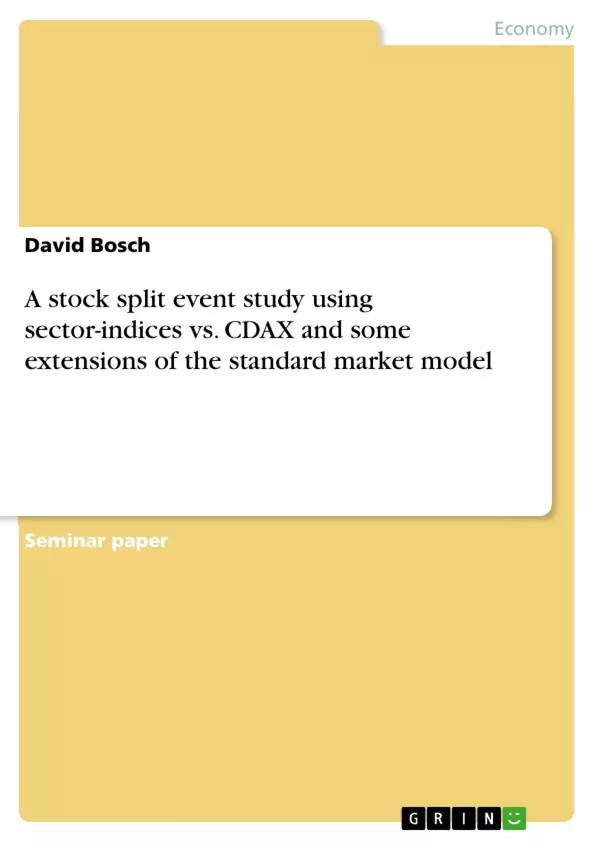There are many theories in literature which try to examine possible reasons for a stock split. While a stock split seems to be just a cosmetic corporate event, it is often claimed that the motivation to carry out a stock split is to signal future profitability or to bring the share price to a preferred trading-range. Additionally there are many papers published, where the impact of a stock split on liquidity and institutional ownership is examined. Some results of these studies are briefly discussed in the Literature Review.
Most researchers calculate their abnormal returns with the market model by using the most common index in their economy. In this paper, I check whether sector-indices fit the data better than the CDAX does. In some cases, the sector-indices describe the stock returns better.
Another topic of event studies that researchers of the finance area often deal with is whether the assumptions of the market model established by Fama, Fisher, Jensen and Roll (1969) do hold for daily stock returns. I will discuss some of the weaknesses when applied to financial time series and I present two models which can improve the efficiency of the model.
Inhaltsverzeichnis (Table of Contents)
- 1 Introduction
- 2 Literature Review
- 2.1 Signaling hypothesis
- 2.2 Trading-range hypothesis
- 2.3 Other hypothesis
- 3 Data and Methodology
- 3.1 Data
- 3.2 Calculating Abnormal Returns
- 3.3 Standardized Residual Test
- 4 Empirical Results
- 5 Problems and Extensions of the Standard Market
Model
- 5.1 Assumptions of the Market Model
- 5.2 GARCH-adjusted Market Model
- 5.3 Time-varying beta in the Market Model
- 6 Conclusion
Zielsetzung und Themenschwerpunkte (Objectives and Key Themes)
This seminar paper aims to examine the impact of stock splits on stock returns in the German stock market, exploring different theoretical perspectives and methodologies to evaluate the event. The paper investigates whether sector indices provide a better fit for calculating abnormal returns compared to the CDAX, the main German stock market index. Additionally, it investigates potential shortcomings of the standard market model, proposing extensions to account for issues related to financial time series.
- The rationale behind stock splits, including signaling hypothesis, trading range hypothesis, and other theories.
- The effectiveness of sector indices versus the CDAX in predicting abnormal returns.
- The limitations of the standard market model for analyzing financial time series.
- Potential extensions to the market model, such as GARCH-adjusted and time-varying beta models.
- The application of event study methodology to analyze stock split events.
Zusammenfassung der Kapitel (Chapter Summaries)
- Chapter 1: Introduction: Provides an overview of the research topic, outlining the importance of stock splits in corporate finance and highlighting the specific focus of the study. The paper aims to analyze stock split events in the German market using sector indices and explore potential limitations of the standard market model.
- Chapter 2: Literature Review: This chapter reviews existing literature on stock splits, focusing on the signaling hypothesis, trading range hypothesis, and other explanations for stock splits. It also discusses the empirical findings from previous studies, highlighting both supporting and contradicting evidence. This section examines the impact of stock splits on liquidity, institutional ownership, and the role of signaling in the German context.
- Chapter 3: Data and Methodology: This chapter outlines the data used in the study, including stock prices of 13 German companies that experienced stock splits between 2006 and 2008. The chapter explains the methodology used to calculate abnormal returns, including the market model and the estimation of parameters. The use of sector indices and the CDAX for the analysis is also discussed.
- Chapter 4: Empirical Results: This chapter presents the results of the empirical analysis, focusing on the relationship between stock splits and stock returns. The results are discussed in the context of the different hypotheses presented in the Literature Review, evaluating the explanatory power of the signaling, trading range, and other theories. The chapter also analyzes the performance of sector indices compared to the CDAX in predicting abnormal returns.
- Chapter 5: Problems and Extensions of the Standard Market Model: This chapter discusses potential limitations of the standard market model when applied to financial time series data. It explores the assumptions of the market model and examines potential issues related to these assumptions, such as non-constant variance. Two alternative models, the GARCH-adjusted market model and the model with time-varying beta, are presented as potential solutions to these issues.
Schlüsselwörter (Keywords)
This seminar paper focuses on stock splits, event studies, market model, abnormal returns, sector indices, CDAX, GARCH model, time-varying beta, liquidity, institutional ownership, and signaling hypothesis in the context of the German stock market.
- Citation du texte
- David Bosch (Auteur), 2009, A stock split event study using sector-indices vs. CDAX and some extensions of the standard market model, Munich, GRIN Verlag, https://www.grin.com/document/176261



